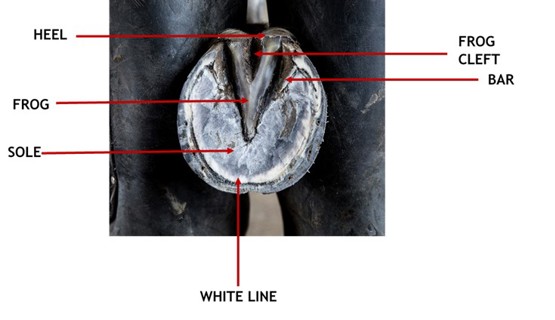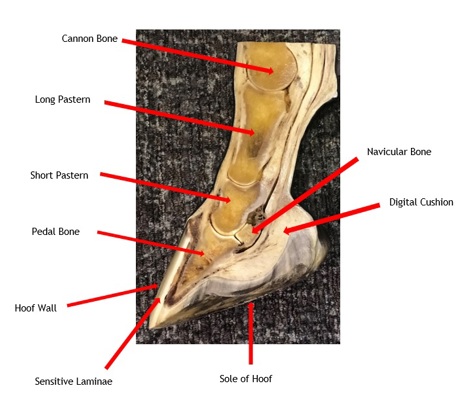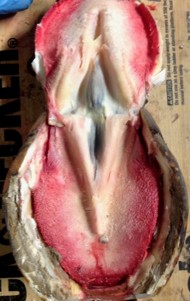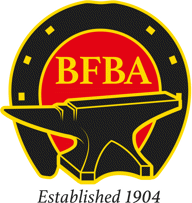External structures (points of the hoof)

Hoof wall
chevron-down
chevron-up
This is the exterior part of the hoof that can be seen and encases the internal structures offering a hard layer of protection. The material which makes up the hoof wall is keratin-based, which is also known as ‘horn’. Keratin is a protein and is the same material which makes up human hair and fingernails. It takes approximately 9-12 months for the horn to grow from the coronary band to the toe1. The hoof wall should be smooth in appearance, with no obvious dips, grooves, lines or bulges.
Coronary band
chevron-down
chevron-up
The coronary band is located where the skin joins the hoof wall. It has a rich supply of blood vessels to provide nourishment to the hoof and creates new tissue which makes up the hoof wall.
Sole
chevron-down
chevron-up
The sole is located underneath the horse’s foot and is also made up of horn. It’s a tough structure which provides protection to the internal, sensitive parts of the hoof. The sole is usually slightly curved and shouldn’t come into contact with the ground. This helps absorb concussive forces as the shape allows the hoof to expand when weight-bearing and contract when lifted.
Frog
chevron-down
chevron-up
The frog is a triangle-shaped structure and is softer than the horn. This structure plays an important role in weight-bearing, absorbing concussion and circulation. The grooves along the side of the frog allow it to expand when in contact with the ground.
Bulbs of the heel
chevron-down
chevron-up
The bulbs of the heel are of a similar texture to the frog. The heels in conjunction with the hoof wall aid shock absorption by moving in and out as well as up and down. The heels can flex independently to better support the horse when moving across uneven ground2.
The white line
chevron-down
chevron-up
The white line forms where the hoof wall meets the sole of the foot. It’s the only visible part of the horse’s laminae; it’s therefore very important to monitor the white line closely for stretching or signs of infection. Stretching may occur due to poor foot balance, limb conformation, incorrect (uneven) weight-bearing, poor riding, poor farriery and an overweight horse. Stretching can also allow bacteria to become trapped within the hoof wall causing an infection known as white line disease, commonly referred to as seedy toe.
Internal structures

Sensitive sole
chevron-down
chevron-up
The sensitive sole lies underneath the pedal bone but above the outer sole. The sensitive sole produces new horn to the insensitive sole when it’s worn away.
Digital cushion
chevron-down
chevron-up
This is a mass of flexible material that contributes to the formation of the horse’s heels. These structures are the main shock absorbers. Located between the pedal bone and the digital flexor tendon, the cushion also helps to push blood back up the leg2.
Collateral cartilages
chevron-down
chevron-up
These structures are in place to provide protection to the coffin joint both on the inside and outside of the hoof wall. They allow the back of the hoof to become more flexible for concussion, absorption and when tackling different terrains.
Collateral cartilages
chevron-down
chevron-up
These structures are in place to provide protection to the coffin joint both on the inside and outside of the hoof wall. They allow the back of the hoof to become more flexible for concussion, absorption and when tackling different terrains.
Laminae
chevron-down
chevron-up
The sensitive and non-sensitive laminae are complex structures which interlock and connect the outer hoof wall to the pedal bone and cartilages. The sensitive laminae act like Velcro to form a strong bond to support the pedal bone within the hoof. The division between the two laminae can be identified by the white line on the sole of the foot.

Photo Credit: Nigel Brown AWCF
Sensitive laminae visible within the hoof capsule
Pedal bone
chevron-down
chevron-up
The pedal bone is arched in shape which gives this relatively small bone the strength to bear the weight of the horse. It spreads the pressure created by distributing weight through the entire bone to reduce tension.
Navicular bone
chevron-down
chevron-up
The navicular bone, also known as the distal sesamoid, is located at the back of the pedal bone and is held in place by two ligaments. The bone sits inside the navicular bursa - a pocket of synovial fluid which allows the deep digital flexor tendon to glide over the bone smoothly3. The navicular bone and the bursa sit within the coffin joint.
Find out more
Supported by Nigel Brown AWCF on behalf of the British Farriers and Blacksmiths Association.

References
- Pollitt, C. (2015) The Illustrated Horse’s Foot.
- Kauffman, S. & Cline, C. (2018) The Essential Hoof Book.
- Ag-Agele, R. et al., (2019) The Anatomy, Histology and Physiology of the Healthy and Lame Equine Hoof.
Get in touch – we’re here to help
The Horse Care and Welfare Team are here to help and can offer you further advice with any questions you may have. Contact us on 02476 840517* or email welfare@bhs.org.uk – you can also get in touch with us via our social media channels.
Opening times are 8:35am-5pm from Monday–Thursday and 8:35am-3pm on Friday.
*Calls may be recorded for monitoring purposes.


